Kingdom Plantae Family Aizoaceae Genus Sceletium Higher classification Sceletium | Order Caryophyllales Subfamily Mesembryanthemoideae Scientific name Sceletium tortuosum Rank Species | |
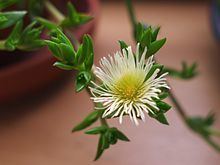 | ||
Similar Lion's ear, Mitragyna speciosa, Sceletium, Kava, Elephant creeper | ||
Sceletium tortuosum is a succulent plant commonly found in South Africa, which is also known as Kanna, Channa, Kougoed (Kauwgoed/ 'kougoed', prepared from 'fermenting' S. tortuosum) - which literally means, 'chew(able) things' or 'something to chew'.
Contents
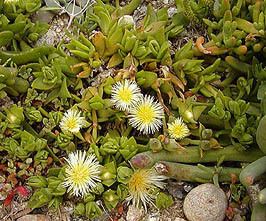
The generally recognised eight Sceletium species are S. crassicaule, S. emarcidum, S. exalatum, S. expansum, S. rigidum, S. strictum, S. tortuosum and S. varians. Per Klak et al. (2007), an alternative classification for the Sceletium group is Mesembryanthemum crassicaule, M. emarcidum, M. exalatum, M. expansum, M. archeri (S. rigidum), M. ladismithiense (S. strictum), M. tortuosum and M. varians.
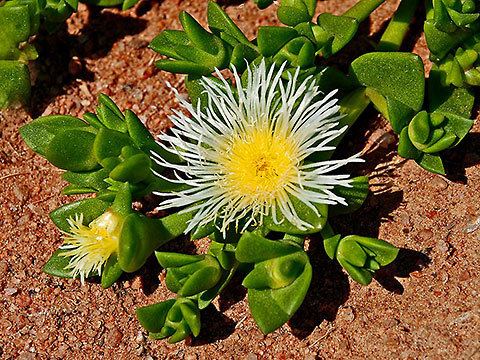
History
The plant has been used by South African pastoralists and hunter-gatherers as a mood-altering substance from prehistoric times. The first known written account of the plant's use was in 1662 by Jan van Riebeeck. The traditionally prepared dried Sceletium was often chewed and the saliva swallowed, but it has also been made into gel caps, teas and tinctures. It has also been used as a snuff and smoked.
Uses
S. tortuosum is traditionally used to relieve pain and alleviate hunger.
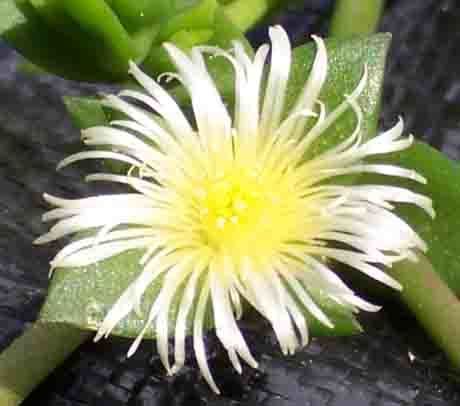
S. tortuosum has been studied to alleviate excessive nocturnal barking in dogs and excessive nocturnal meowing in cats, both diagnosed with dementia.
Effects
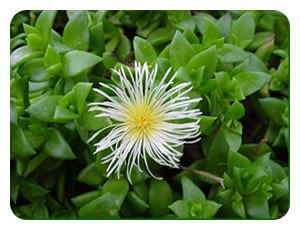
S. tortuosum may elevate mood and decrease anxiety, stress and tension. Intoxicating doses can be euphoric but not hallucinogenic, contrary to some literature on the subject. According to anecdotal reports, it may potentiate the euphoriant effects of cannabis.
Pharmacology
S. tortuosum contains about 1–1.5% total alkaloids. The alkaloids contained in S. tortuosum believed to possess psychoactivity include mesembrine, mesembrenone, mesembrenol and tortuosamine. A standardised ethanolic extract of dried S. tortuosum had a IC50 for SERT of 4.3 μg/ml and for PDE4 inhibition of 8.5 μg/ml.
Mesembrine
Mesembrine is a major alkaloid present in S. tortuosum. There is about 0.3% mesembrine in the leaves and 0.86% in the leaves, stems, and flowers of the plant. It serves as a serotonin reuptake inhibitor with less prominent inhibitory effects on phosphodiesterase 4 (PDE4). In an in vitro study, a high-mesembrine Sceletium extract showed monoamine releasing activity by upregulation of vesicular monoamine transporter 2 (VMAT2).
Mesembrenone
Mesembrenone on the other hand serves as a more balanced serotonin reuptake inhibitor and PDE4 inhibitor.
General
Traditional and contemporary methods of preparation serve to reduce levels of potentially harmful oxalates found in S. tortuosum. An analysis indicated levels of 3.6-5.1% oxalate, which falls within the median range for crop plants, just like spinach or kale. It is speculated that physical crushing of the plant and the fermentation process reduce the potentially harmful effects of oxalic acid. In particular, free oxalic acid is likely to complex with cell wall-associated calcium salts and precipitate as calcium oxalate when plant material is crushed.
Animal studies
No treatment-related adverse effects were observed in an oral toxicity study in rats of a standardized hydroethanolic extract of S. tortuosum. The extract, although not mesembrine itself, produced ataxia in rats, thereby possibly limiting the usefulness of the extract as an antidepressant.
C-reactive protein levels increasing significantly in a dose-dependent manner in unstressed control rats but not in mildly psychologically stressed rats.
Human studies
The long history of traditional human use suggests but does not prove that S. tortuosum is relatively safe for human consumption. Use of the 2:1 standardised extract in healthy adults at a dose of up to 25 mg once daily over a three-month period was well tolerated.
